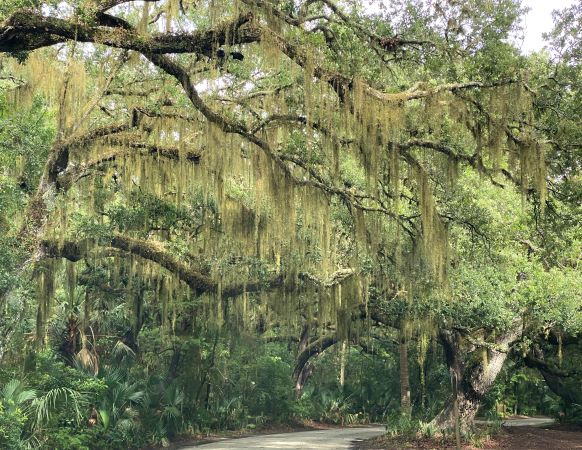By Pat Foster-Turley, Ph.D.
November 25, 2021

Autumn is a beautiful time here on Amelia Island. The weather has cooled down, most of the annoying insects are gone, and the scenery is colorful. We may not have the famous fall leaf colors of the mountains to our north, but we do have our own fall sights.
Any visitor to the Egans Creek Greenway these days are sure to notice the blooming saltbush. These tall tree-like shrubs are so nondescript they are invisible to most of us most of the year. But now, they burst into bloom. The plants are dioecious (have two sexes) and their flowers are different. Male plants have yellowish flowers and females have white fluffy ones. When the flowers burst their seeds are spread like snow in the air. It’s our own “winter wonderland” of sorts.
In Fort Clinch State Park the live oak tree canopy is adorned with yellow grape vines and red poison ivy and Virginia creeper vines, that add an even more festive touch to the gray draping Spanish moss and the epiphytic resurrection ferns that change from dead-looking to vibrantly green in mere moments it seems after a rain. This year is the first time I noticed that rain changes the color of the Spanish moss too. After a heavy downpour and the Spanish moss gets wet enough, the plants turn a greenish color that doesn’t last long. When dry again, the Spanish moss turns its usual drab grey color.

There’s another unusual plant I’ve just discovered at Fort Clinch too, with the help of Ranger Chelly Tabor who reported it first. This plant, an Indian pipe plant, sometimes called a ghost plant due to its white coloration. This plant does not contain chlorophyll like most other plants, and does not need sunlight to grow. Instead it is a parasite on some fungus that is associated with the roots of other forest trees, and it indirectly gets its nutrition from the rest of the forest. At this writing, it may still be there if you want to look for it. Chelly gave us directions to find it, “It’s below a bike trail stop sign on the path a bit north of the large dune.” It took Bucko and I awhile checking various entrances where the bike trail enters the main park road, but we succeeding at last. Maybe you can find it too.
The salt marsh is showing its own colors these days too. The term “golden isles” refers to the yellow color of the marshes this time of year, as the old Spartina grasses fade before new bursts of green growth develop again in a few months’ time. With the exceptionally high tides and strong winds as of late, the salt marshes in our interior have a new look too. Recently I rode my bike “Rocket” over to Crane Island and traversed the long dock jutting out into the marsh. I couldn’t help but notice all the wrack piled up along the marsh edge. This jumble of dead marsh grass gets pushed into the marsh where it forms big clumps that will smother and kill all the living Spartina underneath it. But have no fear. This influx of nutrients ultimately feeds the soil and soon enough more grass will sprout there again. And in the meantime the wrack makes a fine new habitat and food sources for crabs and snails and other marine life that inhabit the area.
Even in my own backyard the fall colors and sights are stunning now. The bald cypress trees we planted as small saplings twenty years ago are not maybe 30 feet tall, and have turned bright orange, before they will lose their leaves entirely and become “bald”. Another native plant in our yard, a sumac tree, has bright green leaves and clusters of bright red berries that provide food for wildlife and could be harvested and dried and used as a food seasoning if one goes to all the trouble involved. Not me—I am happy just admiring it and letting the birds have their harvest.
Here’s hoping you all get outdoors and admire the sights around us now in the Fall. Although I don’t begrudge you a trip up to the mountains to “see the leaves” if you look around you, we have fall sights to see too. Enjoy!
Pat Foster-Turley is a zoologist on Amelia Island. She welcomes your nature questions and observations. patandbucko@yahoo.com
